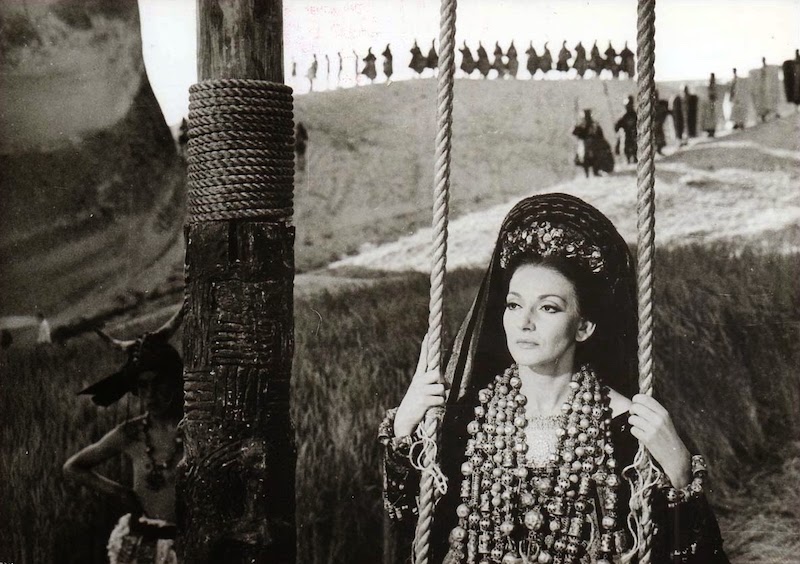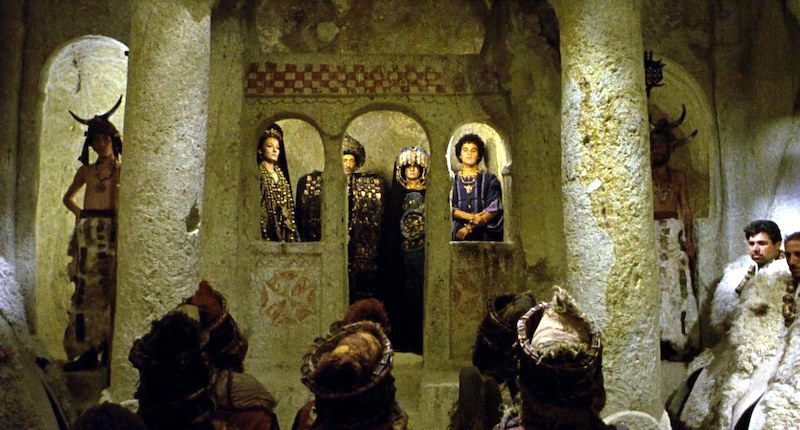Mikhalis Kakogiannis’ 1962 Greek film of the Euripides play straddles a reality which is ours, and yet not quite. Its characters are human, all too human; they inhabit an earthy world, yet they follow a course which seems to be predestined, with stylised speech and ritualised movement. Where Medea was a feast of sets and costumes, Electra gets its strength from plot, character, choreography and camera.

The highlight of the film is undoubtedly actress Irene Papas, who also appears in the other parts of Kakogiannis’ ‘Greek Tragedy’ trilogy, The Trojan Women and Iphigenia. Striking, somewhat androgynous, she is stripped down to simple clothes, hair and make-up. She plays the part of Electra, who was banished when her father Agamemnon came back from the Trojan War, and was murdered by his wife and her lover. Humiliated into an arranged marriage with a farmer, Electra bides her time, and when her brother joins her in exile, they plot their revenge.

Aside from the prologue and a few other scenes, the film is set entirely around the simple farm on which Electra lives. The strongest impression we get of the city is the gargantuan walls, with small figures moving against the huge stones. Agamemnon, when we first see him, is likewise gigantic, shot from below. Gone for a decade, he’s become a mythical figure in the child Electra’s eyes. Only then, when she throws herself in his arms, does he become a man of human scale again, before being brought down by his wife and the usurper.

The outdoors is earthy; we see clouds move through the skies, sometimes becoming a character in their own right, a plough pulled through dank earth and still women, their heavy long dresses moving in the breeze. These women are both a Greek chorus and a coven, protecting and literally shielding Electra whenever intruders enter their domain. First it is Electra’s brother who comes out of his own exile. When he walks to and fro, the women move with him, just as Electra turns to keep facing him. Scenes like this could just have been two people talking, but instead it is used to prop up the idea of a heightened reality, a pseudo-reality. We’re in the ancient Greece of Troy, not that of history.

Another visitor, at Electra’s invitation, is her mother, queen Clytemnestra. She explains why she killed her husband and Electra’s father, and apologises. There is no starker contrast possible between these two powerful women: Electra with her inner strength, and her mother, whose royal bearing seems to come as much from her dazzling clothes and make-up as from her controlled movement; controlled power emanates from her.

Whereas the reckoning with Agamemnon’s murderer, the usurper Aeghistus, happened off-screen and almost off-handedly. This is a story about women, and Clytemnestra’s killing is the lynchpin of the movie. She is led into the farmhouse in which Electra’s brother Orestes waits. At her screams, Electra’s women panic. They hurl themselves around in their black cloaks, as crows fly off from the treetops and a horse bolts. This is not a murder that is being committed, it is a taboo being broken. Only the enslaved Trojan women Clytemnestra brought remain impassive. They care not. The contrast between the frantic movement and the stillness that follows is powerful. It’s a held breath, but then the women slowly rise: the Gods have not descended, and their world has not ended.
Throughout the film, you feel the constant presence of the Gods, yet they do not reveal themselves. The drama, in the end, is one on a human scale.












